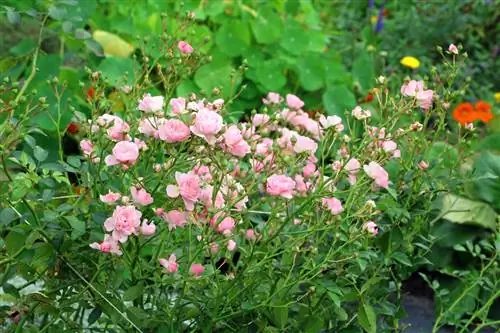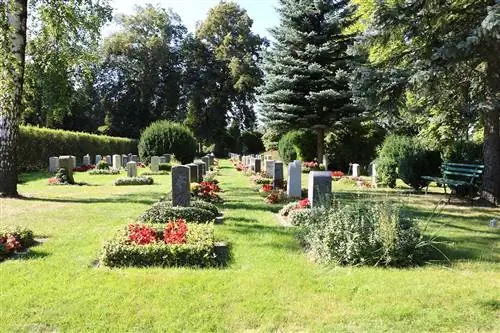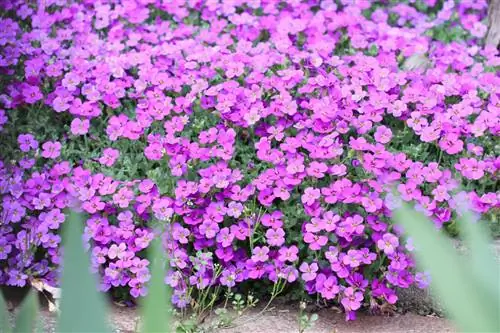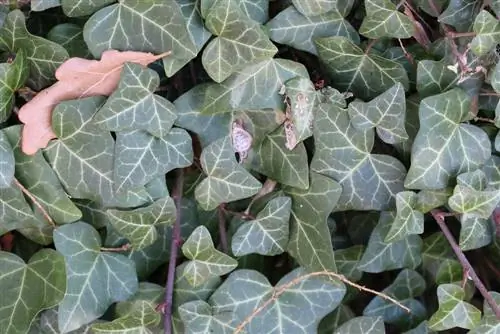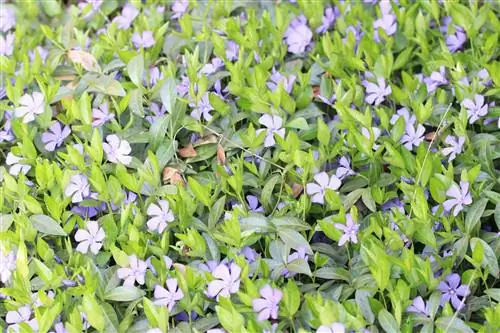- Author admin [email protected].
- Public 2023-12-17 03:39.
- Last modified 2025-01-24 12:45.
Strictly speaking, these are small shrub roses. They stay low and spread in a creeping manner. Their dense branching can suppress weeds, strengthen slopes and transform entire areas into colorful carpets of flowers.
Profile
- Plant family: Rosaceae
- Growth: prostrate, wide, upright, bushy, with overhanging shoots
- Growth heights: 25-100 cm
- Foliage: dense, shedding leaves
- Flowers: in clusters, different colors, mostly double, light scent
- Flowering time: from late spring to frost
- Main flowering time: June
Site conditions
Roses are true sun worshipers and should therefore be kept as sunny as possible. As long as it is bright enough, they are content with a spot in partial shade. They love open areas; the air should be able to circulate well at all times so that the leaves can dry quickly after a downpour. She doesn't particularly like hot places or drafts.
Soil requirements
Regardless of the variety, the ground cover rose requires a permeable, deep, medium-heavy, loamy to clayey, humus- and nutrient-rich soil. A pH value between 5.5 and 6.5 is ideal. If necessary, the soil must be prepared accordingly. It should be loosened well without pulling up the lowest layer of soil. A heavily compacted soil must be loosened more deeply, otherwise there is a risk of waterlogging forming. Green manure can also be useful. What you should definitely avoid is planting roses where there were already roses.
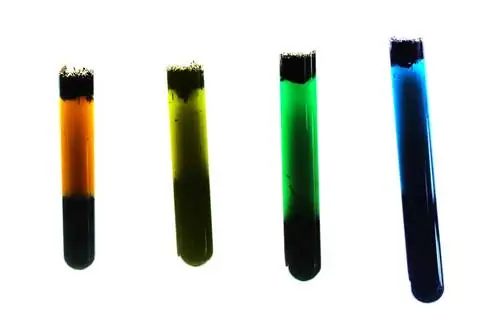
Consider soil fatigue
Soil fatigue occurs especially in rose plants when the same species are planted one after the other in the same location. The direct proximity to some types of vegetables or fruit trees can also be problematic. The new roses grow poorly, sprout only weakly and flower production is also significantly restricted. This makes it all the more important to pay attention to the right location when planting. Otherwise, only a very generous replacement of the floor will help. Roses grow poorly on soils that are tired of roses, even after more than ten years.
Tip:
Mixing larger amounts of rose-tired soil with he althy soil is not sufficient. On the other hand, green manure can make sense, among other things. with marigolds and yellow mustard.
Planting instructions
When planting, a distinction is made between different root qualities. This includes both bare root and container or potted products. While container roses are grown in pots, bare-root roses do not have a ball of soil.
Time
Ground cover roses are best planted in autumn until frost occurs. This way they can take root well until next season. If the ground is frost-free, planting is also possible between December and February. Some hobby gardeners prefer spring, i.e. mid-March to May. In general, bare-root roses should be planted immediately after purchase. Short-term storage should not exceed 3-4 days. Container goods can be planted almost all year round as long as the ground is frost-free. Cuttings are an exception; they are usually planted in summer.
Planting in the bed
- Water root ball independently before planting
- shorten bare-rooted plants above the grafting point
- when planted in autumn approx. 35 cm
- in spring about 20 cm
- also shorten the roots a little
- no shortening necessary for container plants
- Dig a planting pit, at least 40 cm deep and wide
- Mix the excavated earth with a little rose soil if necessary
- no compost or other fertilizer for planting
- Loosen the soil in the planting hole well
- Insert ground cover rose in the middle
- fill with excavated earth, press earth down
- The grafting site must be covered with soil by approx. 5 cm
- water regularly after planting and for weeks afterwards
After the rose has been watered, it is advisable to pile it up with soil so high that about a hand's width still sticks out. The piling is intended to initially protect them from sun, wind and frost. They are only removed when the rose has sprouted another ten centimeters.

In the planter
- Bucket should be at least 40 cm deep and wide
- Drainage holes in the bottom of the pot for good water drainage
- Fit the pot with drainage first
- made of pottery shards, gravel or expanded clay
- Plant cuttings like for bed planting
- Fill the bucket with some rose soil
- Insert rose and fill with soil
- Planting depth corresponds to that in the bed
- Carefully hit the pot several times while filling
- to fill possible cavities in the root area
- Water the ground cover rose afterwards
- replace soil after about three to four years
Planting spacing
The planting distances for ground-cover roses vary depending on the variety. Basically, 40-80 cm or two to five plants per square meter or two specimens per linear meter are recommended. Flat-lying and bushy-growing varieties should be at least 40 cm apart. For those with arched, overhanging side shoots, you should be guided by the respective growth height. To cover the entire surface of the ground, three to five plants are recommended for short-growing varieties and two to three plants for vigorously growing ones.
Tip:
Care also plays a role in planting spacing, because the larger they are, the more weeds can develop. If the plants are too dense, it will be difficult to care for them, for example when loosening the soil.
Pouring
Immediately after planting, water thoroughly and then in the following weeks orregularly in the first year. Later, it only needs to be watered when it is hot and dry in summer, ideally with low-lime water. Make sure to only water the root area and not over the leaves. With a layer of mulch on the root area, moisture can be retained in the soil for longer. However, you should only mulch in the summer from the second year onwards.
Fertilize
The first time fertilization is carried out when the ground cover rose has grown and the fresh shoots are around 10-20 cm long. Distribute 80-100 g of rose fertilizer per square meter and rake it in. Existing roses are supplied with fertilizer in the same way in early spring. Between May and the end of June, a further dose of 40-60 g per square meter may be useful. Slow-release fertilizers should only be applied in spring. A delayed application in July can lead to frost damage over the winter.
Tip:
An undersupply of nutrients should be avoided, as it can promote infestation with lice, fungi and other plant diseases.
Cutting
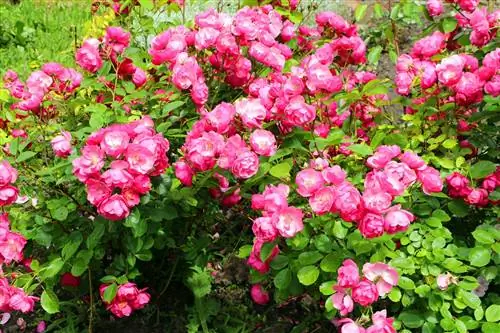
The ideal time to prune is in spring. Permanent frosts are then usually no longer an issue and the roses begin to sprout. In particularly mild locations, cuttings can also be made in autumn.
- Pruning generally every three to four years
- remove frozen, diseased, dead and wild shoots in spring
- shorten all others by about two thirds
- cut about five millimeters above an outer bud
- cut off one or two old main shoots to encourage new growth
- more radical cut every four to five years
- cut back up to 15 cm
- remove wilted flowers regularly
Wintering
Ground cover roses are hardy, but should still be protected from cold and frost, especially in the first winter. To do this, pile them up about 20 cm high with soil, compost or bark mulch before the first frost. Alternatively, you can also cover them with pine branches. The winter protection should be removed again from around mid/end of March. If you leave it on the plant for too long, it can cause rot.
Propagate
Cuttings
- best time during the growing season
- between June and early August
- cutting this year's fresh shoots
- at least one flower at the end of the shoot should be open
- Middle area cuttings are best suited
- each cutting should have 2-3 eyes
- Cut off shoot tips including flowers and buds
- except for the top one, remove all leaves
- finished cuttings about pencil length
- Place individually in pots with potting soil
- only one eye and the top sheet should still be visible
- Press the substrate lightly and pour it on
After watering, the pots and cuttings are covered with a plastic cover and placed in a shady place. The cover should be removed every one or two days, the whole thing ventilated and, if necessary, rewatered. If a new shoot appears, the rooting was successful and the cutting can be transplanted into the garden a few weeks later.

Cuttings
- Cuttings propagation during dormancy
- Cut cuttings between October and November
- only use mature wood
- divide the woody shoot into 17-20 cm long cuttings
- then completely peel off the leaves
- insert directly into the ground at the final location
- If necessary, thin the soil with sand before planting
- top eye should look out of the ground
- Keep the soil moist from now on
- Fleece cover protects against frost
Fungal diseases
If the roses are too dense, too wet or the air cannot circulate properly, fungal diseases can occur. This can be rose rust, star sooty mildew, powdery mildew or bark spot disease. As a rule, affected parts are cut off down to the he althy wood and the plants are treated with an appropriate fungicide.
Aphids, rose sawfly, rose leaf wasp
Damage caused by the most common pests is primarily seen on the leaves and buds. Here, too, it is advisable to cut off and dispose of affected parts of the plant. Spraying with preparations containing neem oil helps against aphids. Otherwise, approved pesticides can be used to combat sucking insects.

